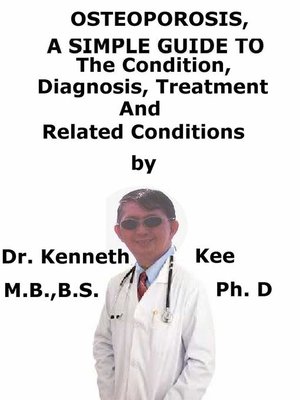Osteoporosis, a Simple Guide to the Condition, Diagnosis, Treatment and Related Conditions
ebook
By Kenneth Kee

Sign up to save your library
With an OverDrive account, you can save your favorite libraries for at-a-glance information about availability. Find out more about OverDrive accounts.
Find this title in Libby, the library reading app by OverDrive.



Search for a digital library with this title
Title found at these libraries:
| Library Name | Distance |
|---|---|
| Loading... |
This book describes Osteoporosis, Diagnosis and Treatment and Related Diseases
Osteoporosis is a disease that attacks the bones in your body. It happens to really almost everyone when they get really old. But for women, after menopause, they can lose up to 30 percent of their bone mass.
Ann Richards
I have severe osteoporosis. Your bones start to collapse.
Joan Kirner
Osteoporosis also known as porous bones is a medical disorder in which the bones become weak and brittle, resulting in a greater likelihood of low-impact, fragility fractures after minor trauma.
There is removal and replacement of bone continuously happening in the body.
When bone is removed faster than it can be replaced, osteoporosis happens.
Osteoporosis is a silent disorder.
People with osteoporosis often do not recognize that they have the disorder.
Osteoporosis often produces fractures in the wrist, spine and hip.
With their loss of function, persons with hip fractures then need to depend on others.
The vast majority of people with osteoporosis have primary osteoporosis.
It is normally a late-onset osteoporosis caused by a lack of estrogen, calcium, and vitamin D.
It is characterized by a lack of bone density and weak bones.
Women with primary osteoporosis have normally been through menopause and men with primary osteoporosis are normally older too.
Primary osteoporosis is linked to:
1. The aging process together with
2. Decreasing sex hormones.
The bones have deterioration in micro-architecture leading to loss of bone mineral density and higher risk of a fracture.
The most frequent form of osteoporosis is primary osteoporosis, which is the result of a normal physiological process, such as menopause or aging.
One manifestation of primary osteoporosis, termed postmenopausal osteoporosis, is the result of a rapid loss of bone linked with the decline in estrogen levels in women during the 3 to 5 years before menopause, at menopause, and after menopause.
Normally, bone loss increases in the first few years of menopause and then starts to level off.
The effects are most well-known in trabecular bone which is not as dense as compact bone.
Secondary Osteoporosis
Other diseases or their treatments cause secondary osteoporosis.
Men are much more likely than women to have secondary osteoporosis.
Medications that can lead to secondary osteoporosis are:
1. Glucocorticoids and
2. Anti-epileptics.
Other medications are less well studied but suspected to also contribute to osteoporosis such as:
3. Chemotherapy agents,
4. Proton pump inhibitors, and
5. Thiazolidines.
Disease states that can cause osteoporosis are:
1. Hyperparathyroidism,
2. Anorexia,
3. Malabsorption,
4. Hyperthyroidism, or
5. Over-treatment of hypothyroidism,
6. Chronic renal failure,
7. Cushing Syndrome, and
8. Any disease that can lead to long-term immobilization.
Secondary amenorrhea can also lead to rapid loss of bone mass for more than one year from various causes such as:
1. Non-estrogen hormonal therapy,
2. Low body weight, and
3. Excessive exercise.
Diagnosis
Patients with a diagnosis of osteoporosis should have laboratory assessment of their renal and thyroid function, a 25-hydroxyvitamin D and calcium level.
The World Health Organization (WHO) has established dual x-ray absorptiometry tests scans of the central skeleton is the best test for assessing bone mineral density.
The purpose of osteoporosis treatment is to prevent bone fractures by stopping bone loss and by...







